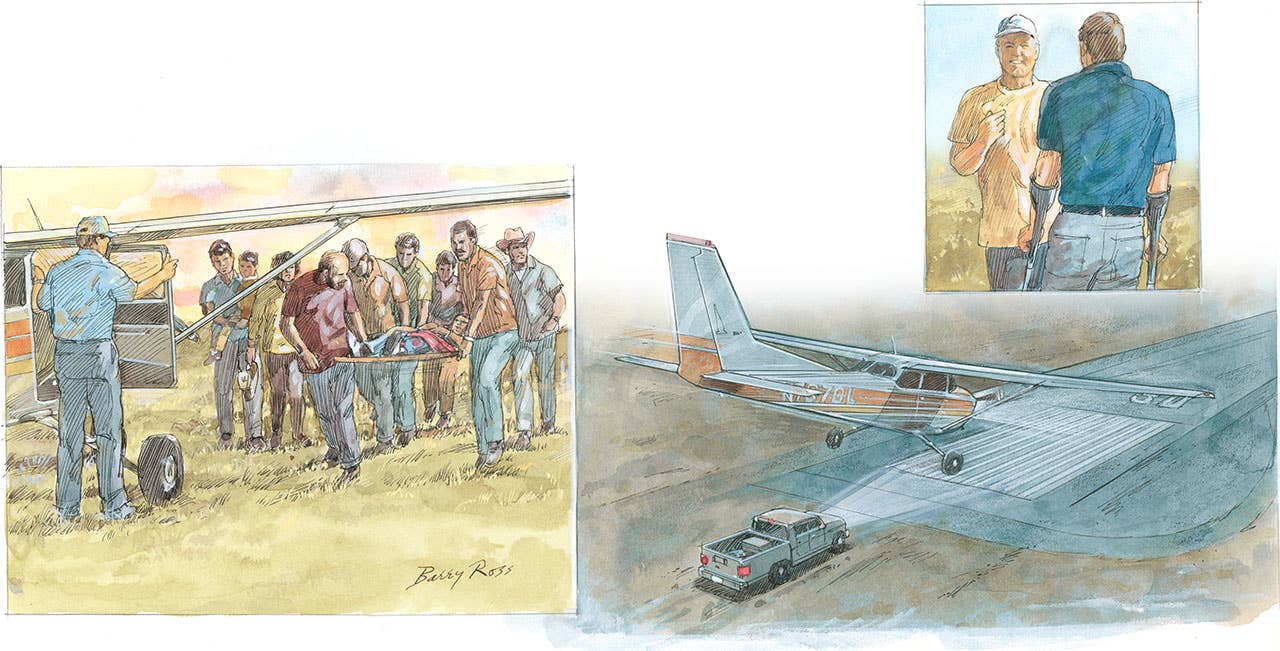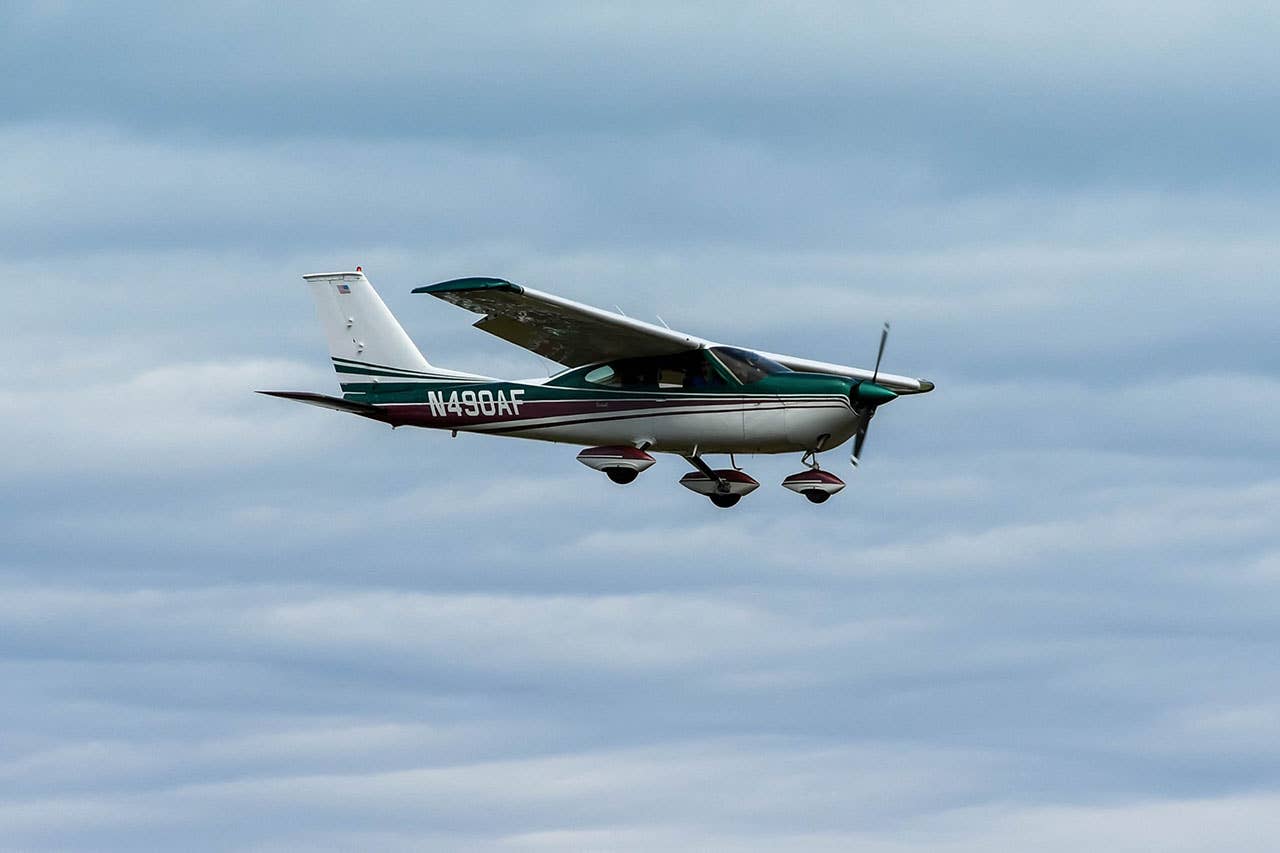
Illustration by Barry Ross
I was camped on the beach when the aroma of grilled shrimp drifted my way. It was a sure way to stimulate my appetite. I had spent the day flying and clearing U.S. and Mexican customs. My destination was a small resort in Baja California. My inflight snacks just didn't cut the mustard for curing my hunger pangs, and I was really looking forward to a shrimp dinner at the only restaurant for 60 miles. The two-table restaurant served the best shrimp dinner this side of New Orleans, but it didn't come to fruition.
I had flown my Cessna 172 South to Punta San Francisquito in Baja California, Mexico, to pick up two brothers. As I approached the resort, I saw them lying on the beach. The runway is usually a natural dry bed, though sometimes times it's a mud bog. It was dry that day. To announce my arrival, I buzzed them. I'm sure they were not impressed with the Skyhawk fly-by. Their father was a pilot with the Blue Angels. I landed, and the brothers walked up to greet me. They had driven their GMC truck to the resort, a God-awful dirty place in the arid desert on the Sea of Cortez. One either loves it or hates it. The plan was for them to leave their truck at the resort for future use when they would fly back to the resort. Then I would fly them back home the next day to Montgomery Field and Long Beach in California. In exchange, I got the use of the truck when I flew to the resort. A good deal for both parties.
It was time for dinner, and the three of us were walking along the beach toward the restaurant, about 100 yards from our campsite. I saw the caretaker of the little resort, a woman named Chary, walking toward us with a man I didn't recognize. We all met up, and Chary introduced us to the gentleman, who didn't speak English, and said the man's brother had been seriously injured when he was struck by a truck while riding his motorcycle. She asked if I could fly the injured brother to a hospital. I wondered, "Is he really seriously injured?" I was hungry and wanted the shrimp dinner. I could see by the look on the man's face, however, that he was desperate to get help for his brother. It was getting dark, and if we were going fly the brother to the nearest hospital, we needed to get moving. The nearest hospital was 80 miles to the west in Guerrero Negro (Black Warrior), on the Pacific side of the Baja peninsula.
The injured brother was at a cattle ranch about 10 miles south of San Francisquito, called Rancho El Barril. I said firmly, "We need to get moving." I loaded up the gentleman and took off toward Rancho El Barril. We landed at the dirt strip at El Barril just a few minutes later. The gentleman was disappointed and frustrated that his injured brother wasn't at the dirt runway. We waited, and a few minutes later, a large group of people, many of them crying, arrived. Poly, the injured brother, was being carried to the plane on a piece of plywood. His injured leg was wrapped with a blood-soaked T-shirt. As I took out the backseat to make room, several men lifted Poly into the rear of the plane. Poly's brother climbed into the co-pilot seat, and I buckled him in. The sun had set as we took off on the long sandy runway. If I couldn't land at Guerrero Negro, my alternate plan was to fly to either San Felipe or Ensenada, as both have lighted runways.
â"She asked if I could fly the injured brother to a hospital. I wondered, ’Is he really seriously injured?' I was hungry and wanted the shrimp dinner. I could see by the look on the man's face, however, that he was desperate to get help for his brother."
I had been to Guerrero Negro many times before and had the GPS coordinates in my list of recent destinations. Night had fallen as we flew over the mountainous backbone of the Baja Peninsula. Once on the west side of the mountains, I made a radio call in the blind on the Unicom frequency. The runway is not lighted, and the tower was closed. Surprisingly, I got a response. Someone at El Barril had called someone in Guerrero Negro and told them that we were on our way. I radioed and asked if someone would turn on their headlights at the approach end of the runway. The runway is paved and long. Moments after the radio call, the headlights appeared. As I got closer, I saw a red flashing light on the highway heading toward the airport.
It was a new experience for me, landing at an unlighted runway at night. I kept descending until I saw the long black asphalt runway. Even with my landing light on, I still couldn't see the runway until I was just ready to touch down. Guerrero Negro is located on the Pacific coast of Baja on the Viscaino Plain. Luckily, there is not a hill or mountain in any direction for probably 30 miles. As I landed, I could see the red flashing light was on an ambulance. I parked on the ramp, and the ambulance personnel quickly unloaded Poly, and off they went. The hospital at Guerrero Negro, I learned, is well-equipped.
Several locals came to the plane and offered me a free dinner and lodging in town for the night. They made me feel like a hero. They were so, so grateful.
I accepted the dinner but told them that I would sleep in the plane. Later, after I'd returned to my Cessna, I was awoken by someone knocking on the door of the plane. It was a man and a woman. They had brought me blankets and a pillow. These folks were the best, so considerate. I was exhausted after the long day, so getting to sleep was not a problem.
I got up at daybreak to fly back to San Francisquito. I was looking forward to the early-morning low altitude flight over the desert and mountains. As I turned eastbound, I saw an ambulance with a red flashing light coming to the airport. I found out later that the doctors at the hospital couldn't repair Poly's broken leg, and they were going to fly him, in a different plane, to Hermosillo on the mainland of Mexico. Hermosillo has even a bigger and better hospital. Poly later told me they couldn't fix him there, either, so they flew him to La Paz to see orthopedic specialists.
I made it back to San Francisquito and met up with the brothers, the ones I'd originally flown down here to give a lift to. We had breakfast at the restaurant, and off we went back to the U.S. We cleared Mexican customs at Tijuana and Brown Field in the U.S. I dropped off one brother at Montgomery Field and now had to fly to Long Beach to drop off the other brother. That final leg was back to San Diego's Fallbrook airport. The whole time, I wondered if all this flying and no relaxing was worth the use of the old GMC truck.
Eventually, I got my answer. Over the years, I have flown in to visit Poly at Rancho El Barril many times. The first time, he was lying in bed, and he couldn't get around. His leg didn't heal properly. It was so badly injured, the doctors couldn't repair the leg. He was so appreciative; he said, "You saved my life." Other times when I went to see him, he wasn't at the ranch.
Then, just last year, about 20 years after the motorcycle accident, I lost my mind and drove to San Francisquito, 12 hours from San Diego. The last three hours were on a rough dirt road. Juan and his son, Lionel, are the caretakers now. They were there with another man, dressed nicely in a button-up shirt. He was on crutches, but I still didn't recognize him. As I fixed drinks for the four of us, we munched on salted peanuts in the shell and drank our cold beverages. We were sharing stories and having a good time when Juan said to me, while pointing at the man on crutches, realizing that I hadn't made the connection, "That's Poly!" It was just a coincidence Poly was visiting San Francisquito at the same time as I'd happened by. We were happy to see each other again after not seeing each other for about 10 years.
The four of us celebrated the reunion with a seafood dinner. Juan and Lionel prepared freshly caught lobster, fresh scallops and a nice salad.
Baja has spoiled me as a fly-in destination, the beautiful Sea of Cortez and unspoiled deserts. I was fortunate to have been able to help someone, which made the trip even more special to me. And the lobster, not to mention the company, was better than that shrimp dinner I'd missed years before could ever have been.
Do you want to read more Lessons Learned columns? Enjoy "Memories Of A Former Spitfire Pilot" here.

Subscribe to Our Newsletter
Get the latest Plane & Pilot Magazine stories delivered directly to your inbox






